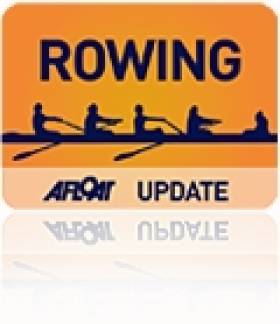Displaying items by tag: Niall Kenny,
Lightweight Men Hit Heights in Newry
ROWING: Niall Kenny of UCC headed up a group of lightweight men at the top of the rankings after the 5,000 metre time trial at the second National Assessment in Newry. The top lightweight woman, Siobhan McCrohan also impressed – her percentage of projected world best time was 84.7 to Kenny’s 84.9. The fastest woman of the day was under-23 heavyweight Lisa Dilleen, and the junior women and men set a high standard, with Bridget Jacques and Andrew Griffin topping their classes. Sanita Puspure (ill) and Holly Nixon (injured) could not compete and Shane O’Driscoll and Paul O’Donovan missed out because of a bereavement.
National Assessment, Newry (5,000 metre time trial; Provisional Results - Percentages based on projected world winning time in athlete's class)
Niall Kenny (UCCRC) LM1x 19:37.3 84.9%
Michael Maher (Three Castles) LM1x 19:42.8 84.5%
Mark O'Donovan (CITRC) LM1x 19:55.5 83.6%
Anthony English (UCCRC) LM1x 19:55.9 83.6%
Justin Ryan (UCCRC) LM1x 19:56.4 83.6%
Nathan O'Reilly (Tideway Scullers’ School) LM1x 20:20.3 81.9%
Jonathan Mitchell (QUBBC) LM1x 20:23.1 81.8%
Sean O'Connor (NUIGBC) HM1x 20:21.3 80.2%
David Neale (UCD) HM1x 20:28.5 79.8%
Eddie Mullarkey (NUIGBC) HM1x 20:37.4 79.2%
Conor Egan (NUIGBC) LM1x 21:10.0 78.7%
Patrick Hughes (DUBC) HM1x 20:50.3 78.4%
Adam Boreham (BBC) HM1x 20:55.2 78.1%
Christopher Beck (RBAIRC) LM1x 21:22.5 78.0%
Feargal Geraghty (NUIGBC) LM1x 21:24.5 77.9%
Mark O'Brien (St Michaels) HM1x 21:23.6 76.3%
Matthew Wray (Bann RC) HM1x 22:27.1 72.7%
Siobhan McCrohan (Tribesmen RC) LW1x 21:38.1 84.7%
Claire Lambe (UCDBC) LW1x 21:42.0 84.5%
Lisa Dilleen (CITRC) HW1x 21:13.5 83.4%
Sarah Dolan (DULBC) LW1x 22:26.0 81.7%
Monika Dukarska (Killorglin RC) HW1x 21:59.7 80.5%
Sinead Dolan (DULBC) LW1x 23:05.7 79.4%
Andrew Griffin (Neptune R.C.) JM1x 20:39.2 83.0%
David Quinlan (Castleconnell Boat Club) JM1x 21:02.0 81.5%
Patrick Boomer (MCB) JM1x 21:02.2 81.5%
Aodhan Burns (Skibbereen R.C.) JM1x 21:03.2 81.5%
Cathal Phelan (Offaly RC) JM1x 21:03.7 81.4%
John Mitchel (Lee R.C.) JM1x 21:04.3 81.4%
Mathew Ryan (Skibbereen R.C.) JM1x 21:06.4 81.3%
Paddy Hegarty (Skibbereen R.C.) JM1x 21:12.6 80.9%
David O'Malley (St Michaels) JM1x 21:18.6 80.5%
Paudie Leonard (Skibbereen R.C.) JM1x 21:21.5 80.3%
Andrew Bell (Col.Iognaid) JM1x 21:22.0 80.3%
Cian Noone (Neptune R.C.) JM1x 21:25.1 80.1%
Andy Harrington (Shandon B.C.) JM1x 21:26.1 80.0%
Daniel Buckley (Lee R.C.) JM1x 21:30.9 79.7%
Gearoid Moore (St Michaels) JM1x 21:37.6 79.3%
Gary Thornton (Portora BC) JM1x 21:40.0 79.2%
Thomas English (Neptune R.C.) JM1x 21:43.6 78.9%
Eddie Beechinor (Cork BC) JM1x 21:52.7 78.4%
Conor Carmody (Shannon RC) JM1x 21:55.2 78.2%
Darragh McCarthy (Col.Iognaid) JM1x 21:58.9 78.0%
Kevin Fallon (St.Joseph's) JM1x 22:09.5 77.4%
Mathew Kelly (Col.Iognaid) JM1x 22:22.3 76.7%
James Healy (St Michaels) JM1x 22:35.1 75.9%
Brian Keohane (Presentation College, Cork) JM1x 22:39.9 75.7%
Philip Mc Entee (GRC) JM1x 22:56.3 74.8%
Kai McGlacken (Col.Iognaid) JM1x 23:15.5 73.7%
Bridget Jacques (BBC) JW1x 22:22.6 83.0%
Hilary Shinnick (Fermoy RC) JW1x 22:37.0 82.2%
Katie Cromie (Portora BC) JW1x 22:39.2 82.0%
Kate O'Brien (St Michaels) JW1x 23:00.1 80.8%
Aileen Crowley (Muckross RC) JW1x 23:19.3 79.7%
Bernadette Walsh (Skibbereen R.C.) JW1x 23:22.0 79.5%
Leonie Hamel (Cork BC) JW1x 23:33.4 78.9%
Sarah Higgins (Cork BC) JW1x 23:36.9 78.7%
Sarah Allen (Bann RC) JW1x 23:37.9 78.6%
Fionna Murtagh (GRC) JW1x 23:44.1 78.3%
Roisin Merz (Shandon B.C.) JW1x 23:50.0 78.0%
Jasmine English (MCB) JW1x 23:51.9 77.9%
Phoebe Mulligan (Portora BC) JW1x 23:56.4 77.6%
Aoife Cooper (Muckross RC) JW1x 23:59.9 77.4%
Kara O'Connor (Muckross RC) JW1x 24:18.3 76.5%
Sadhbh Cassidy (Neptune R.C.) JW1x 24:18.8 76.4%
Maria Gregson (MCB) JW1x 24:20.3 76.4%
Katherine Cremin (Muckross RC) JW1x 24:31.5 75.8%
Claire Silke (Castleconnell Boat Club) JW1x 25:01.4 74.3%
Megan McLaughlin (Cork BC) JW1x 25:03.0 74.2%
Crainne Malone (Col. Charrian) JW1x 25:11.9 73.7%
Megan Donnelly (GRC) JW1x 25:23.2 73.2%
Zoe Hyde (Killorglin RC) JW1x 25:33.5 72.7%
Henry Millar/Lloyd Seaman (Portora BC/Portora BC) JM2- 19:47.5 82.2%
Kevin Keohane/Niall Crowley (Presentation College Cork) JM2- 20:05.5 81.0%
William Yeomans/Colm O'Riada (Commercial) JM2- 20:09.5 80.7%
Joel Cassells/Chris Alcorn (Bann) JM2- 20:10.4 80.7%
Aidan Kinneen/Eric McEvoy (St.Joseph's) JM2- 20:30.9 79.3%
Shane Walsh/Alan Murtagh (Galway RC) JM2- 20:40.5 78.7%
Killian Doyle/Aaron McGrath (Carlow) JM2- 20:55.3 77.8%
Brooke Edgar/Emily Hutchinson (Bann) JW2- 22:29.0 79.8%
Hanna McCarthy/Hanna O’Sullivan (St Michael’s) JW2- 22:40.7 79.1%
Ruth Gilligan/Lauren McHugh (Shannon) JW2- 22:51.9 78.5%





























































